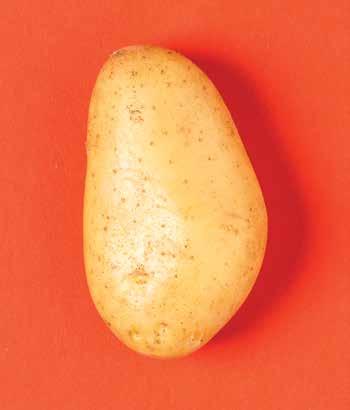
19 minute read
A True Bozman Beauty
Fresh Take
POTATOES
By Dylan Roche
“Po-tay-toe,” “pah-tah-toe”…however you pronounce the name of this root vegetable, you shouldn’t deny its nutritional advantage. Although potatoes are often regarded as a starch and sometimes shunned by low-carb eaters, they’re a dietary staple in many cultures and for good reason. They’re hearty, versatile, and packed full of essential vitamins and minerals. So, with St. Patrick’s Day coming up in March, you can feel good about putting as many potato dishes on the menu as you want!
Even before potatoes came to be associated with Ireland, they were sustaining populations halfway across the world in South America as far back as 8000 BC. The Spanish Conquistadors brought potatoes back to Europe after they conquered Peru in the 16th century, and the popularity of potatoes spread. In Ireland, the culture came to be so dependent on potatoes as a primary part of their diet that when a fungus wiped out most of the crops between 1845 and 1854, it took a devastating toll on the Irish population and became known as the Great Potato Famine.
Today, most people eat potatoes in some kind of processed or heavily prepared form, and this might be where people get the notion that they’re not a vegetable. As Eat Fresh, a resource put out by the U.S. Department of Agriculture, points out, foods like French fries, chips, and hash browns usually have added fat and salt. On the other hand, a simple medium-sized baked potato has only about 150 calories, no fat, 3 grams of protein, and about 37 grams of complex carbohydrates for sustained energy.
Taking a look at the nutritional profile of potatoes, you can see how potatoes help fuel a healthy body—there’s fiber for good digestion, potassium for fluid balance and heart health, iron for red blood cell formation, Vitamin C for fighting oxidation, thiamine for a strong nervous system, and niacin for good circulation.
When you’re picking out potatoes at the market, you’ll encounter several varieties—expect them to be similar nutritionally, but they will have different tastes and textures that lend themselves better to different purposes: Russet potatoes: These are the classics you probably think of when you picture a potato. They’re oval-shaped with a brown, roughly textured skin dotted with lots of eyes. The Produce for a Better Health Foundation notes that their low moisture and high starch make them an ideal pick when you’re looking for potatoes to bake. Red potatoes: These are smaller, sometimes about the size of a golf ball, with a thin reddish-brown skin. The Produce for a Better Health Foundation recommends red potatoes for boiling, roasting, or frying. Yellow potatoes: You’ll recognize yellow potatoes by their golden skin, and although they are highly versatile, their high moisture content makes them great for boiling to make mashed potatoes, according to the Produce for a Better Health Foundation.
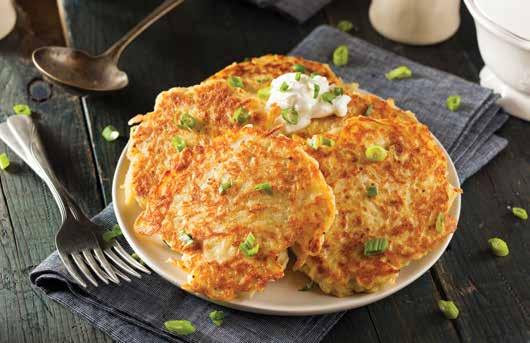
When you’re picking out potatoes, pay attention to their skin—you want ones with smooth, unblemished skin and no sprouting on their eyes. If a potato has shriveled or bruised skin, it’s damaged or spoiled. When you bring them home, store them in a cool, dark, dry place, and wash them immediately before preparing them.
Ready to find something delicious to do with potatoes? These recipes are great for a light meal or a delicious side dish:
Irish Boxty
A classic that’s perfect for St. Patrick’s Day
INGREDIENTS:
2 large Russet potatoes, grated 1 large yellow potato, boiled and mashed 1 cup whole-wheat flour 1 tablespoon cream 1 egg 1/4 cup finely chopped chives 1 teaspoon parsley 1 teaspoon thyme 1 teaspoon salt 1 teaspoon pepper 1/2 cup canola oil
DIRECTIONS:
Place the grated Russet potatoes and chives in a large bowl and toss them with flour. In a separate bowl, combine the mashed yellow potato, cream, and egg. Slowly add to the grated potatoes and combine thoroughly. Add parsley, thyme, salt, and pepper. Form the mixture into patties and set aside on wax paper. In a large skillet, heat canola oil over medium heat. Add the potato patties and allow them to cook for about 4–5 minutes on each side until golden brown. Remove from the skillet and set them on a plate lined with paper towels. Serve with sour cream or marinara sauce and sauteed vegetables.
Potato and Broccoli Casserole
A healthier take on muchloved comfort food
INGREDIENTS:
5 medium-sized Russet potatoes 5 cups broccoli florets 1 cup vegetable stock 1 1/2 cups goat cheese 2 tablespoons cornstarch 1/4 cup olive oil 1 teaspoon whole-grain mustard 1 tablespoon chopped chives 2 cups grated part-skim mozzarella 1/4 teaspoon paprika 1/4 teaspoon cumin 1/4 teaspoon salt 1/4 teaspoon pepper
DIRECTIONS:
Preheat the oven to 400 degrees F. Cut the potatoes into cubes and chop the broccoli florets into small pieces. Bring a large pot of water to a rolling boil and set the potatoes in to cook for approximately 10 minutes. In a separate pot, use a steam basket to cook the broccoli until tender, approximately 5 minutes. In a small saucepan, warm the vegetable stock and olive oil over low heat. Whisk in the cornstarch until thickened, then add the mustard and goat cheese, allowing to melt and combine. Remove from the heat. Drain the potatoes and combine with the broccoli in a large mixing bowl. Add the wet mixture and combine, followed by the chives and shredded mozzarella. Season with paprika, cumin, salt, and pepper. Spread the mixture in a casserole dish and bake in the oven until warm and bubbly, approximately 15–20 minutes. HEALTH & BEAUTY HEALTH
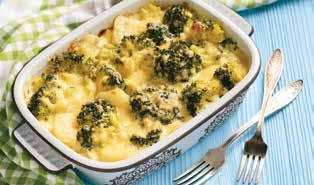
Unplug
IT’S GOOD FOR YOU
By Dylan Roche
If you’re like most people, there’s something you do excessively every day that’s pretty bad for your health. Maybe not as bad as cigarettes or fast food. But cutting back on it might still be good for both your physical and mental wellbeing.
This unhealthy habit? Screen time. Think about how many collective hours you spend staring into your phone, tablet, or computer on any given day. But on National Day of Unplugging—recognized this year from sundown on Friday, March 5, to sundown on Saturday, March 6—people across the country will take a 24-hour break from all their tech devices.
Of course, it’s not practical to swear off your gadgets all the time. But giving them up for a short period helps you realize your potential for going without them more often and ultimately achieve better tech-life balance.
Maybe you’re already aware of the way your tech addiction affects your daily life. According to a January 2018 study published in Digital Health, one-third of adults surveyed admitted they had spent less time with friends and family because they were glued to their phones. Furthermore, one-fifth said a friend or family member had ignored them because that person was on their phone.
Poor tech-life balance affects our wellbeing and quality of life in some unexpected ways. Thinking of learning to unplug more often? Consider some of the ways your life might improve…
You’ll be more active.
Less time in front of a screen means more time to get up and move around. You might not think you waste that much time scrolling through your phone, but a few minutes here and there can add up. This is especially true if you’re opting to check your email or your messages throughout the day. You might have heard of the term “nomophobia”— the fear of being unreachable. Let yourself overcome your fear and recognize that messages can wait. Use 10 or 20 minutes of downtime to go for a walk around the block. Your emails will be there when you get back.
And if you’re somebody who is seriously connected to your phone, you might find that all the time you waste adds up. If you suddenly have an extra hour in your day, you can finally enjoy the full workout you always thought you were too busy to do.
You’ll be less stressed.
Having constant connectivity was supposed to make our lives easier—instead, it has just made our lives harder. You might think that you’re being productive when you’re trying to shift between emails, text messages, web surfing, and whatever else you’re doing on your phone. Instead, you’re dividing your attention so much that you’re not able to accomplish anything sufficiently. what’s known as blue light, wavelengths of light that increase your body’s alertness. That’s great during the day when you need to be awake and responsive—not so much at night. These wavelengths of light will also suppress your body’s production of the sleep hormone melatonin.
Poor sleep leads people to be chronically exhausted and even anxious. While some people have opted to try special glasses that block blue light, or to turn their phone’s settings to night mode, health experts recommend doing the obvious: avoiding screen time at night.
Another stressor is the constant comparison with others. People post polished depictions of their lives on social media and it makes us feel as if our day-to-day activities pale in comparison. The result is a compromised sense of self-worth.
By unplugging, you remove yourself from all the distractions, both the professional and the social. It makes it much easier to focus on your task at hand. You’ll get more accomplished and take a greater sense of satisfaction in it. If your project requires an electronic device, such as your computer, you can set up internet blockers to help you avoid social media sites and other black holes for mindless scrolling.
You’ll get more sleep.
Electronics aren’t just affecting your quality of sleep because you stay up late browsing through Pinterest. Electronics make it harder for you to fall asleep and stay asleep because they emit
You’ll be less strained.
Being off your phone just feels better. People have a tendency to crane over their phones, putting stress on their neck, back, and even their hands. Their posture suffers and they develop stiffness.
It’s also not so great for your eyes. People who spend too much time looking at screens develop what’s known as computer vision syndrome (CVS for short), which is marked by blurred vision, headaches, light sensitivity, and a stinging or burning sensation in the eyes.
Put your phone away—your neck, back, and eyes will thank you for it.
Want more insight into how constant connectivity is affecting your health, plus tips on how you can survive your tech-free 24 hours? Visit www.nationaldayofunplugging.com.
Fitness Tips
STARTING A ROUTINE FOR SENIORS
By Dylan Roche
It’s never too late to pursue physical fitness—in fact, exercise becomes even more important as you get older. That’s because staying active helps offset some of the negative effects of aging, improves quality of life, and helps seniors remain independent. The American Academy of Family Physicians explains that exercise is good for strength, balance, energy levels, cognitive function, and even emotional well-being. It also helps stave off chronic conditions like heart disease and osteoporosis. Seniors who don’t stay active find it harder to do daily tasks like going up stairs, carrying a heavy bag of groceries in from the car, or even walking without assistance.
But this doesn’t mean seniors need to be training the same way they did when they were younger. The National Council on Aging recommends moderate exercise for at least 30 minutes a day, five days a week, including two days of muscle-strengthening activities that target all major muscle groups. The problem is that only one in three Americans over the age of 65 actually meet this recommendation.
If you’re a senior who’s looking to jump into a new workout program-—-or if you’re encouraging an older relative to do so—bear in mind that it’s not as easy (or as safe) to jump into a routine as it was at a younger age. The National Institute on Aging recommends talking to a doctor or health care provider first, especially if there are chronic conditions involved like heart disease, high blood pressure, diabetes, or arthritis. Exercise is still possible with any of these conditions (and these conditions will likely improve with regular exercise), but they do pose safety risks for anyone beginning new physical activity. This is especially true for anyone who has spent many years being sedentary. Be sure to develop a varied exercise routine, one with activities that improve your endurance, strength, balance, and flexibility.
Endurance: These are the exercises that raise your heart rate and breathing—they’re also known as aerobic or cardiovascular activities. They are good for improving your heart, lungs, and circulation, and increasing your energy levels. Great endurance exercises include: walking, bicycling, jogging, swimming, dancing, and recreational sports like tennis or basketball.
Strength: These are the activities that make your muscles stronger and help offset muscle loss as you age. Great strength-training exercises include: lifting weights, using resistance bands, and doing bodyweight exercises like pushups, sit-ups, or lunges.
Balance: These are recreational activities that force you to maintain and improve your stability, ultimately reducing risk of falls. Great activities for balance include: standing on one foot, walking heel-to-toe, and tai chi.
Flexibility: Flexibility exercises are the ones that keep your muscles loose and your body limber so you can move more easily. Great flexibility exercises include: stretching and/or yoga.
Here are two easy at-home exercises recommended by the National Institute on Aging. For more ideas, visit www.nia.nih.gov and select “Exercise and Physical Activity” under the “Health Information” drop-down tab.
Wall Push
1. Stand facing a wall slightly more than an arm’s length away. 2. With your feet shoulder-width apart, lean forward and place your palms against the wall. 3. Keeping your feet flat on the ground, bend your elbows and lean your body in as if you were trying to push the wall away from you. 4. Hold for five seconds before pushing yourself back to starting position. 5. Repeat 10 times or until fatigued. Be sure to maintain good form throughout each rep.
Overhead Arm Raise
1. Stand with your feet shoulder-width apart or sit comfortably on a chair with your feet flat on the floor. Hold a dumbbell in each hand, arms down by your side. 2. Raise the dumbbells up to shoulder level and hold them with your palms facing forward. Slowly raise both dumbbells over your head until your arms are straight. 3. Hold for one second before bending your elbows and lowering both weights down to shoulder level. 4. Repeat 10 times or until fatigued. Be sure to maintain good form throughout each rep.

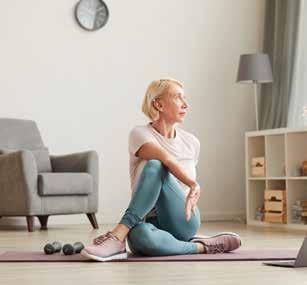
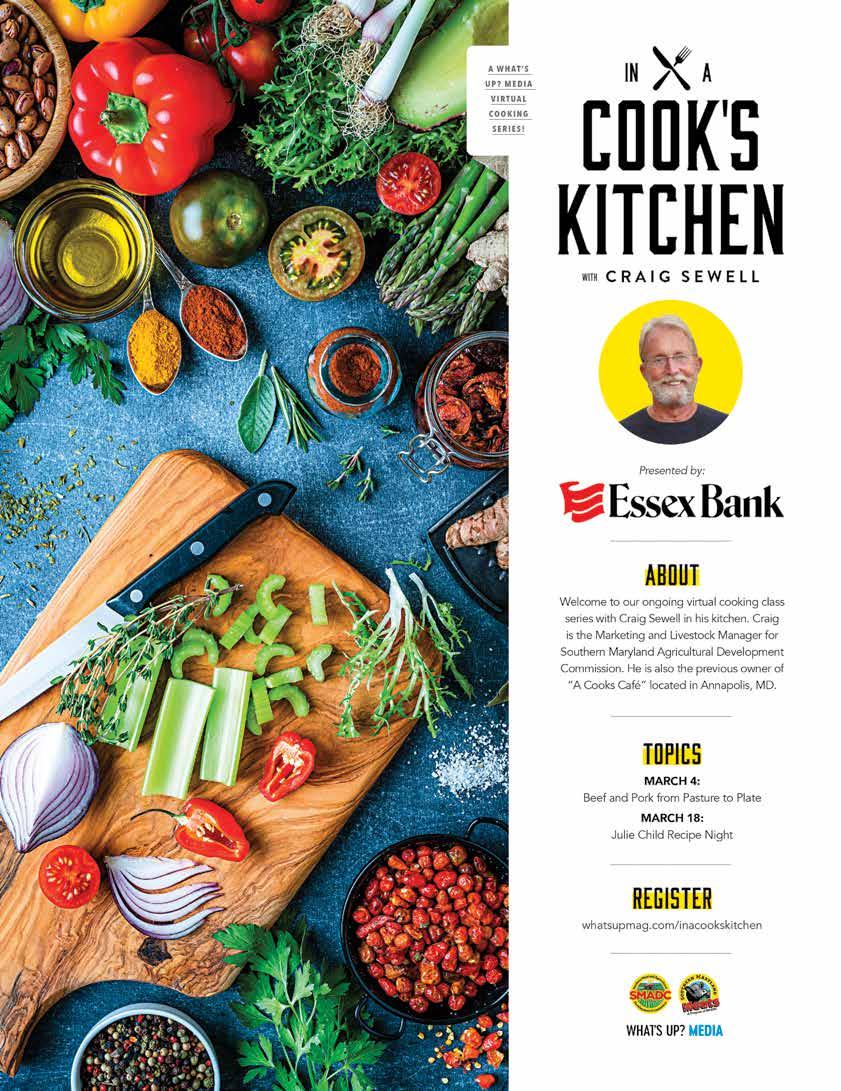
Dining +
58 CULINARY TRENDS | 60 GUIDE
Chimichurri is a dazzling sauce, perfect for meat or vegetable dishes
Calling All Food Critics!
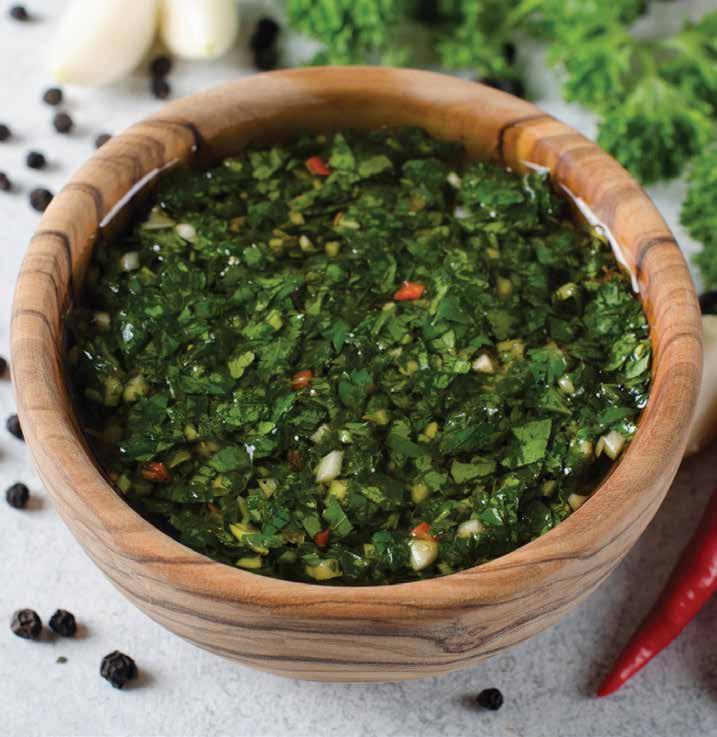
Send us your restaurant review and you’ll be eligible for our monthly drawing for a $50 gift certificate to a local restaurant. Fill out the form at whatsupmag.com/promotions.
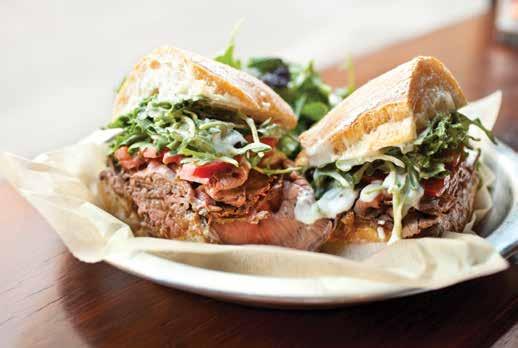
DINING TRENDS
Not All Heroes Wear Capes
We want to join the round of applause that Feed Anne Arundel—founded by Monica Alvarado, owner of Bread and Butter Kitchen in Eastport—has gotten for their incredible work in connecting dozens of area restaurants with the hungry people in our community by raising money to purchase meals from local restaurants (helping them out in this difficult time) and giving them to those in need. Alvarado was honored with the inaugural Annapolis Person of the Year award, and Anne Arundel County provided a $1 million grant to support the effort. You can support it, too, by making a donation at feedannearundel.org.
Savor the Chesapeake

A CULINARY COMPENDIUM OF RESTAURANT, FOOD, AND BEVERAGE NEWS AND TRENDS FROM THE CHESAPEAKE REGION
By Kelsey Casselbury
Hellos and Goodbyes
We love seeing new companies open their doors, but it’s so bittersweet when you also say goodbye to some favorites.
Easton residents got a happy surprise when Old Mill Deli, which permanently closed (in theory) last fall, announced that it would reopen on February 1. The deli serves a variety of breakfast and lunch options, with ever-changing lunch specials. 1021 North Washington Street, Easton | 410-822-9613
From fresh bread to unique breakfast options to lunch sandwiches, the menu at Annapolis’ In Grano Bistro and Bakery sounds like a dream (particularly the Chinese-Stuffed Flatbread, made with pulled pork, scrambled eggs and a ginger sambas dipping sauce). Led by Adam Pusateri and Pericles Lewnes, In Grano—located in Annapolis Technology Park in the former location of Katana Sushi—also features coffee of all sorts (including some intriguing flavors of lattes, such as Lavender and Chai Spice) and plans to offer beer, wine, cocktails, and sake in the future. 302 Harry S. Truman
Parkway, Suite H, Annapolis | ingranobakery.com
It looks like Phillips Seafood wants to reinstate its presence in downtown Annapolis, but not to its Dock Street location that closed in 2015 (and, before that, in 2009). Instead, the Maryland mainstay has submitted a beer, wine, and liquor license for 110 Compromise Street, where they want to serve crabs fresh from the dock outside the restaurant. It’s TBD on whether the county will allow that, so check back! www.phillipsseafood.com There can never be enough coffee shops, so let’s give a shout of excitement for Severna Park’s The Big Bean, which is opening a second location on Bestgate Road in Annapolis this spring. In addition to the menu that you know and love, this location plans to serve nitro coffee on tap and cold brew options. 558 B&A Boulevard,
Severna Park | 888 Bestgate Road, Annapolis (coming soon) | www. thebigbean.com
If you like beer, Anne Arundel’s West County is the place to be— Pherm, a new Gambrills brewery, has joined Chesepiooc in Crofton and Crooked Crab in Odenton to make a trifecta of hops in the area. Owners Billy Abbott and Henry Jager named the brewery after fermentation (which is how beer is made) and the band Phish, and they’ve started out strong with a bevy of brews on tap, including IPAs, a pilsner, sours, and more— in other words, something for everybody. 1041 MD-3, Gambrills |
phermbrewing.com
Other West County news isn’t quite so happy—Houlihan’s, part of a national chain of restaurants, closed its doors at the end of 2020, due to coronavirus-related financial losses. Additionally, according to plans submitted to the county, it seems as if Nautilus Diner—a Crofton-area pillar—will be demolished in the future and replaced with a Sheetz gas station and convenience store. The project is in its early stages, so more details are sure to come.
In the Kitchen: Feeling Saucy
There’s a holiday for every day, week, and month of the year, and most of them are quite suspect (who declares these holidays, anyway?) But, it’s kind of fun to just go with it, so let’s talk sauces in honor of National Sauce Month.
Most cooks know already about the five French mother sauces: Béchamel, Velouté, Espagnole, Tomato, and Hollandaise. If you love to cook and haven’t mastered these yet, what are you waiting for? If they’re old-hat to you, though, here are three more versatile sauces that you should have in your repertoire:
Chimichurri. Similar to pesto, this Argentinian sauce is an uncooked blend of herbs (usually parsley), olive oil, garlic, vinegar and chilies that’s traditionally used on steak, but is dazzling on pretty much anything from chicken to vegetables to rice.
Barbecue. Skip the bottled stuff— homemade barbecue sauce is super-simple (and much lower in added sugar). Recipes vary, but it’s typically a combo of tomato puree (or ketchup), molasses, apple cider vinegar, Worcestershire sauce, and seasonings.
Satay. Also known as peanut sauce, satay originated in Indonesia and is made with ground peanuts or peanut butter, coconut milk, soy sauce, brown sugar, and lime juice at its base, but some cooks also add fish sauce, tamarind, curry powder, and red pepper flakes or other spice.
In case you’re wondering, there are other food-themed celebrations a-plenty in March—it’s also National Fresh Celery Month, Noodle Month, Flour Month, Frozen Food Month, and Peanut Month.

From the Bar: Gin
Before you say it, stop—gin does not taste like a pine tree in a glass. If you’re sticking to that sentiment, you probably haven’t sampled a wide variety of the spirit. Sure, the flavor profile is rooted in juniper berries (which, admittedly, do come from a conifer), but distillers these days experiment with all sorts of ingredients that can really affect the finished product. To prove that not all gins are created equal, the spirit is separated into four distinct varieties:
LONDON DRY. Originating in England but produced globally, this is the most juniper-heavy type of gin, and it’s free from artificial flavoring. It must be made with a neutral base and ring in at a minimum of 40 percent ABV. Use it in a: Gin and Tonic
PLYMOUTH. Both a style of gin and the name of a distillery in the UK (the only one that produces this style), this is drier than London Dry and offers up some citrus at the front and some spice at the back. The
Pot O’ Gold
Serves 1
1 ounce lemon juice 1 ounce raw honey 1 ounce gin*
Combine the ingredients in a shaker with ice and strain into a lowball glass filled with ice.
*Recipe from Gray Whale Gin (www.graywhalegin. com), which supports ocean conservation with each bottle sold—meaning you can feel even better while sipping your cocktail. juniper isn’t quite as prominent. The distillery is also the source of the higher-proof Navy-Strength gin (the British Royal Navy loved it). Use it in a: Martini (which absolutely should be made with gin, not vodka)
OLD TOM. This stuff is a bit sweeter, thanks to the licorice in the distillation (but it doesn’t taste like licorice, thankfully). Sometimes it’s aged in barrels, which can greatly influence the flavor. Use it in a: Tom Collins
GENEVER. This is the OG of gin, dating back to the 16th century in Holland (though some may claim it’s not a gin at all but its own distinct spirit). The base grains are malted, like in whiskey distillation, which produces a richer flavor. You’re not going to taste citrus, and you won’t get as much juniper. Use it in a: Gin Old-Fashioned
All this being said, American distilleries are playing with the definition of gin and expanding what sort of flavors can accompany (or perhaps even mask) the juniper. Don’t believe us? Try one out.




